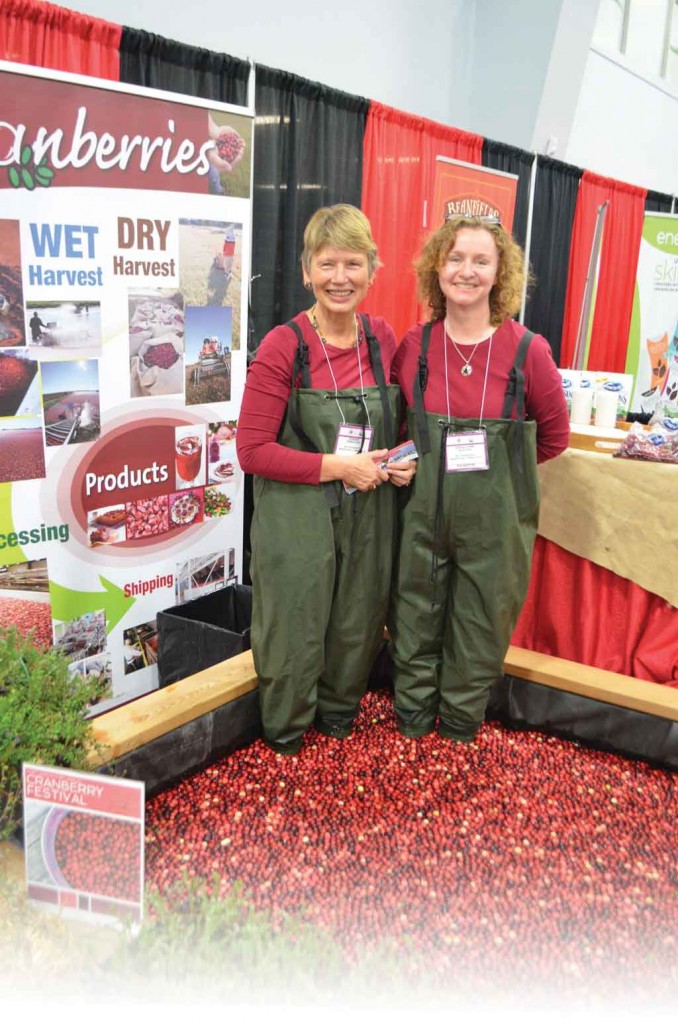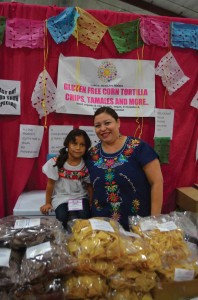By Sasha Moedt and Nadine Moedt (The Cascade) – Email
Print Edition: October 8, 2014

We were greeted at the entrance of the Fraser Valley Food Show by a pair of women decked-out in rubbers and waders standing shin-deep in cranberries.
“We’re here to educate the public about cranberries and the harvest process,” presenter Geraldine Auston said, handing us some craisins. “We’ll be growing 80 to 100 million pounds of cranberries in BC alone.”
Cranberries, Auston explained, are one of the only indigenous berries farmed on such a large scale, along with blueberries and Concord grapes.
That was just one thing of many that we learned about BC farms and food.
Booths lined the Abbotsford Tradex center with a gluten-free theme this year; samples of everything from sausage to fudge were offered to attendees.
The food show is passionate: farmers and small business start-ups have booths where the chef is personally there to tell you about their creations. We spoke at length to Brenda Cortes, owner of Lupita Mexican Foods, about the difference between Taco Time and authentic Mexican cuisine. The hard taco shells, ground beef, yellow cheese and sour cream that we know as Mexican food is an American invention; Cortes’ creations are simple and genuine, based on the real Mexican cuisine she knows. Her store is opening soon in Maple Ridge and, fitting with the theme of the food show, will offer gluten-free options.
Booth highlights included chocolate quinoa muffins from allergy-free Richmond bakery Wise Bites, flavoured honey from Honeyview Farm in Rosedale, samples of surprisingly tasty vinegars and oils — try the strawberry dark balsamic — from All-of-Oils, and the “Audacious” or “Intrepid Mole” coffee blends from Seasoned Gourmand Foods, a company based in Langley.
The annual Fraser Valley Food Show is always good for food inspiration. Our major takeaway: consider buying local products as an investment. Rather than taking your business to Wal-Mart, spend a little more at Lepp Farm Market or Nature’s Pickin’s. If it’s a quick fix you want, look for Surrey-based SpiceWorks Food Creations’ amazing five-minute butter chicken mix. The people you are supporting are passionate, and your purchase is usually more ethically produced. For example, JD Farms’ turkeys sell for a little more than the ones at the grocery store, but they take care to treat their turkeys well. You can even pop by and check out their turkey barn, which is part of the Fraser Valley’s self-guided circle farm tour. The beauty of buying local comes down to accountability: that of the farmer, and that of you as a consumer.
How to pronounce “gouda,” and other cheese wisdom
Beyond the booths, the food show provided seminars on various food-related topics. I was drawn to a presentation on Canadian cheeses that promised a plate of samples.
The seminar, sponsored by the Dairy Farmers of Canada, was given by cheese connoisseur Reg Hendrickson. We were taught how to really taste cheese: first, break or tear the cheese, smell it, place it on your tongue and let it soften, and then swish it around your mouth for a full experience of texture and taste.
Participants were given samples of seven types of cheese from Canadian cheese producers, ranging from “Tiger Blue,” produced by Poplar Grove Cheese in Penticton, to “Boursin Pepper” from Fromagerie in Montréal. Each cheese was broken, examined, sniffed, and eaten with comical gravity.
Hendrickson also gave an introduction to pairing cheeses with other toppings, which can change the taste entirely. Dousing bitter blue with sweet clover honey can take out some of that pungent aftertaste, or adding dried cranberry to some savoury mascarpone can create the perfect dessert cheese. Hendrickson also noted that, while wine is frequently paired with cheese, beer can make just as desirable a companion.
Some cheese works to add colour and decoration to a plate. We sampled some wine-flavoured cheese, an interesting marble of maroon and cream that looks as good as it tastes. When serving cheese at parties, Hendrickson noted that it tastes best if you take it out of the fridge 40 minutes before guests arrive, which gives the cheese time to “relax” and temper before being eaten.
Hendrickson also spoke of the importance of taking care of cheese. Students on a budget pay close attention; caring properly for your cheese can allow your cheese funds go all that much further. For stiff cheese, like cheddar or blue, any mould can be taken off with a knife and the rest used. Soft cheeses like cottage or ricotta will be completely contaminated by mould and have to be thrown out. Keeping cheese cold and clean (Hendrickson suggests washing your hands before unwrapping the cheese) will allow it to keep for longer, and keeping it sealed in an air-tight package like cling wrap will maintain the freshness.
Those with dietary restrictions also have options if they are careful in their cheese selections. For vegetarians, a good tip on choosing cheese without animal-based products is to check the ingredients for “microbial enzymes” rather than the animal by-product “rennet.” There are even options for lactose-intolerant cheese lovers; often during the cheese-making and ripening processes, the lactose is removed from the cheese. Look for cheeses like brie, camembert, mozzarella, Swiss, and gouda.
Just here for the beer
“Wine drinkers spit. Beer drinkers swallow,” Deb Mohabir told the audience. That’s the first thing you need to know about beer-tasting.
In BC, beer is rising in the ranks; it’s become classy to order a craft beer. But that doesn’t mean beer drinkers take themselves too seriously. After telling a story about having to explain to an angry mother that a T-shirt sporting the phrase “A great day starts with a little head” was referring to the foam that settles on top of your beer, Mohabir told us that “you’ve got to do this with a smile on your face.”
With three beers in front of us — a Red Truck lager, a Red Truck ale, and a Fruli — along with a plate of sausage, salsa, and chips, we were ready to taste and pair.
Unlike at the wine-tasting, the presenters, Rick and Deb Mohabir, weren’t telling us the proper pairing, but rather were telling us to observe how food changed the taste of the beer.
“The same beer can taste different with two different foods,” we were told. It’s far less structured than the art of tasting and pairing wine.
The spicy sausage’s fat chased away the bitterness of the ale, with the carbonation washing the fattiness away.
“Beer can clear the palate,” Rick Mohabir explained. One thing I learned is that beer should not be served ice-cold: “Big beer wants you to be served ice cold because that’s what mutes the flavour.”
The Fruli was a delicious dessert beer, pairing well with the mango salsa. The differences between the beers were incredible with and without the various food.
“We’re here to make you guys educated consumers. What are your first impressions? What sticks around? Beers can have floral, citrus, clove, banana, spice flavours … They are incredibly diverse,” Deb Mohabir said.
“The breakfast of champions”
Kathleen Rake couldn’t help but snicker as she opened her seminar on breakfast wine.
“Now we can have wine with every meal,” she told the audience. In front of us sat four glasses of wine: white bubbly, pink bubbly (both Yellowtail), Chardonnay Sauvignon Blanc (Mt. Lehman Winery), and a dark elderberry wine melomel (Campbell’s Honey). Each would be paired with a breakfast food. We started with the white bubbly.
“Never swirl bubbly,” Rake said, explaining that the natural carbonation will release the smell — in this case, fresh citrus and green apple rose. When you take a sip of bubbly, the mousse — the foam from the carbonation — will expand in your mouth.
“The citrus clears the palate and chases away fat,” Rake said after spitting her sample. As a student, I couldn’t bring myself to spit. This wine would pair well with a rich breakfast dish, perhaps an eggs Benedict.
The pink bubbly had a sweeter berry smell. “It’s not nearly as aggressive a bubble,” Rake observed. Sip, hold, savour. It was lighter, gentler: “I can see this pairing very well with bagels, cream cheese, smoked salmon, and capers.”
The Mt. Lehman Chardonnay was very sweet. Any wine that has 11 per cent alcohol content or lower will be sweeter; with higher percentages, the alcohol has “eaten” the sweetness, Rake explained. With this wine, we could swirl.
“Place your hand over the glass to trap the aroma, then stick your nose in,” she instructed us. I could smell apple or melon. It tasted more acidic in my mouth, making it pair well with a rich but less fatty dish like oatmeal.
The elderberry melomel wine was the one I was looking forward to. You could smell the cranberries after a swirl. It tasted smoothly of berries with an almost sickly sweet honey flavour lingering.
“This is very much a dessert wine,” Rake observed — so how about pairing it with a dessert breakfast such as waffles, cream, and strawberries?
After the seminar I popped up to the stage for a chat. Kathleen Rake writes for the Abbotsford News in a monthly column, and has been attending the Fraser Valley Food Show for about five years now.
“It’s been fabulous this year — I’m tasting lots of new wines,” she said. “The wine- and sausage-tasting seminar has been very popular this year.”
Rake invites UFV students to direct questions to her blog, Between the Vines, about all things wine.





